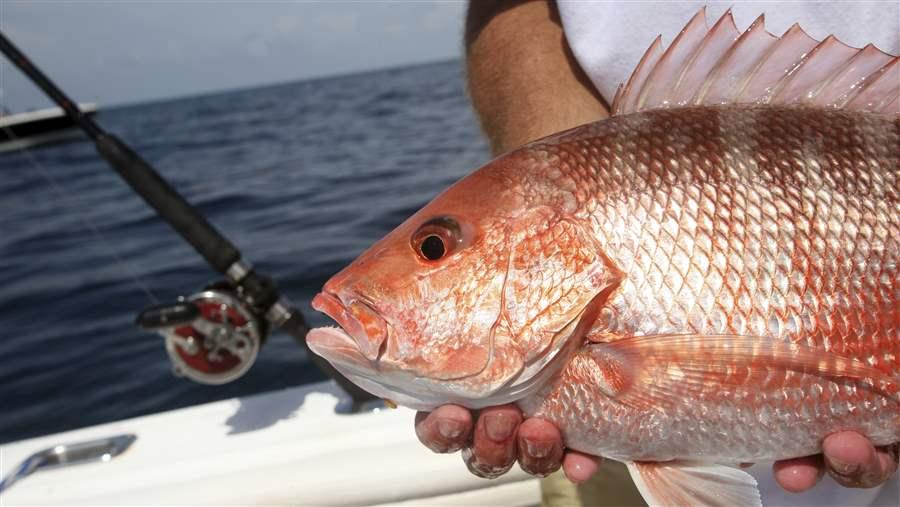Red Snapper Fishing Season Probably Coming Soon to U.S. South Atlantic
Fishery managers must rely on the best science to set rules, catch limits

Fishery managers are fast-tracking a plan to open commercial and recreational fishing for the still-recovering U.S. South Atlantic red snapper.
© iStockphotoAs red snapper continues to recover from decades of overfishing off the southeastern coast of the U.S., efforts by fishery managers to restart fishing of this iconic species are putting science to the test.
A ban has been in place on fishing for the species since 2010, with the exception of a brief period from 2012 to 2014 when scientists determined that a small number of red snapper could safely be taken. But now, the South Atlantic Fishery Management Council, which regulates fishing in federal ocean waters from North Carolina to Florida, is considering how to set catch limits for a summer 2018 red snapper season.
The council’s actions come in response to mounting public frustration. As the red snapper population rebuilds, the prized fish is becoming easier to catch. But under current rules, when fishermen incidentally catch red snapper while targeting other species, they are required to throw the red snapper back. With the species rebounding, the number of released fish is also growing. However, because red snapper are typically a deep-dwelling fish and endure a rapid pressure change when being brought to the surface, many of these released fish don’t survive.
Now, with the idea that a dead fish thrown overboard might as well be a dead fish in the cooler, the council is fast-tracking a plan to reopen commercial and recreational fishing. Several web-based public meetings are scheduled for this week and next, and a final vote is set for September.
However, this speed may come at the price of science, because the council doesn’t plan to have its science advisers review its decision. The advisers’ job is to provide guidance on the number of fish that can be caught while still preventing overfishing. A 2016 study by Southeast Data Assessment and Review determined that too many red snapper are dying incidentally to keep recovery on track.
Fishing opportunities on the table
The 2016 study showed that although the species’ numbers are increasing overall, the population is still below a healthy level, with too few of the older and bigger fish that breed the best. And the researchers estimated that an average of more than 200,000 red snapper died in both 2014 and 2015 through accidental catch—twice what scientists determined the population could withstand.
For more than six months, the council has debated the accuracy of the incidental catch estimates used in the study, with some members saying that although the council’s science advisers have certified the research as the best scientific information available, they do not feel they can rely on its findings. Population estimates are derived by extrapolating from the number of fish caught and by scientifically designed surveys. This combination of sources works well for many species, but because the information on catch comes mainly from fishermen’s reports, those data can be limited when fishing is restricted.
New approaches needed to help recovery
Instead of relying on that approach, the council hopes to use what is known as an index of abundance, which estimates the population not from catch numbers but from counts of fish derived through scientific observations, such as videos and trap surveys.
This method has shown promise, and two groups of scientists are developing approaches for its use on South Atlantic red snapper. They should collaborate on a common strategy and present it to the council’s science advisers to consider when determining whether a 2018 season is possible without allowing overfishing and, if so, a sustainable catch limit.
Fishing for red snapper should resume only if scientists determine it can be done without jeopardizing a healthy future for this popular fish. And if fishing is allowed and fishermen catch more than the annual catch limit, the council should require that those overages be deducted from the next fishing season. In addition, the council needs a clear plan to collect data on how much fishing takes place and how much is caught, and to reduce the number of red snapper thrown back dead. This could include requiring the use of descending devices that help fish adjust to pressure changes when returning to the depths and analyzing the potential trade-offs of a combined snapper and grouper season, which could allow fishermen to keep more red snapper during a set period.
Keeping red snapper on the road to recovery is vital for all the people and businesses that rely on the health of the species: from anglers who enjoy a day on the water, to commercial fishermen and the restaurants and chefs they supply, and to those who never pick up a fishing rod but enjoy healthy, locally caught seafood. This will require long-term, well-informed thinking and collaboration among South Atlantic managers, scientists, and fishermen.
Holly Binns directs The Pew Charitable Trusts’ efforts to protect ocean life in the Gulf of Mexico, the U.S. South Atlantic Ocean, and the U.S. Caribbean.







